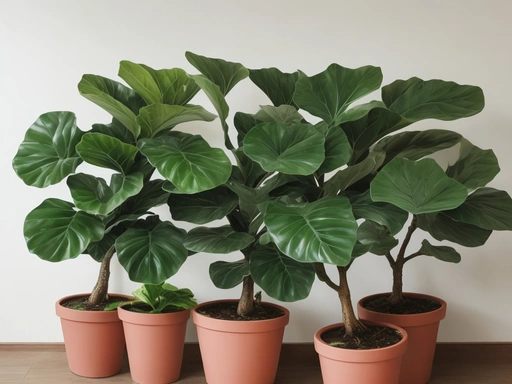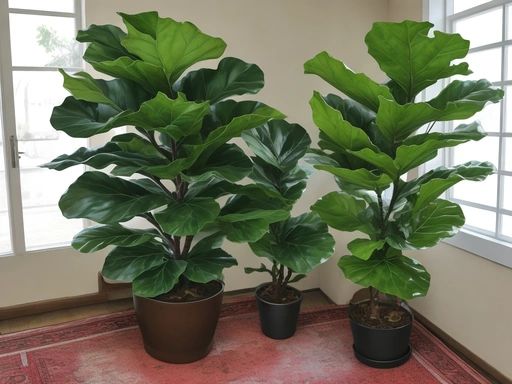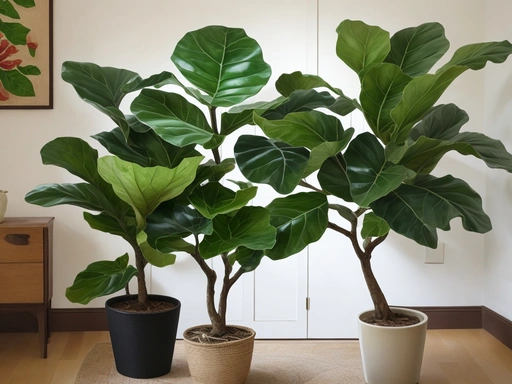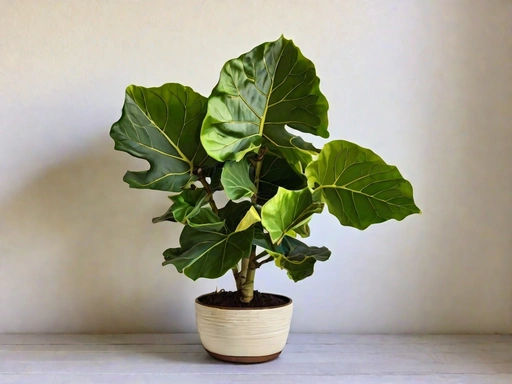Best Indoor Fiddle-Leaf Fig Varieties for a Lush Home Jungle
Key Takeaways:
- Some of the best indoor fiddle-leaf fig varieties include ‘Compacta’, ‘Suncoast’, and ‘Bambino’.
- These varieties are known for their compact growth, making them suitable for smaller spaces.
- ‘Compacta’ has crinkled leaves, ‘Suncoast’ has bright green foliage, and ‘Bambino’ has smaller leaves compared to other fiddle-leaf figs.
- These varieties are relatively easier to care for and can thrive in indoor conditions with proper sunlight and watering.
Hey plant lovers! Looking to add a touch of green to your indoor space? Look no further than indoor Fiddle-leaf fig plants! These trendy and beautiful plants have taken the world by storm, becoming a must-have for plant enthusiasts everywhere.
In this article, I’ll guide you through the best indoor Fiddle-leaf fig varieties, helping you choose the perfect one for your space.
We’ll also discuss the benefits of having these plants indoors and how to care for them properly. Get ready to bring nature inside and create a stunning oasis with these incredible indoor plants.
Let’s dive in!
| Name | Description | Pros | Cons |
|---|---|---|---|
| Ficus lyrata | The original and most common variety. Large, violin-shaped leaves. | – Easy to find and purchase – Tolerates low light conditions – Well suited for indoor environments – Makes a stunning statement piece in any room | – Prone to pests and diseases – Requires regular pruning and maintenance – Sensitive to changes in environment, temperature, and watering |
| Ficus lyrata ‘Compacta’ | A dwarf variety with smaller leaves and a more compact growth habit. | – Easier to manage in smaller spaces – Well-suited for apartments and small rooms – Still retains the beautiful foliage of the original variety | – Requires frequent and regular watering – May lose leaves if not provided with adequate light – More difficult to find and purchase |
| Ficus lyrata ‘Bambino’ | A miniature version of the fiddle-leaf fig with small, rounded leaves. | – Perfect for small spaces and desktops – Less demanding in terms of care and maintenance – Tolerates low light conditions better than other varieties | – Slower growth rate compared to other varieties – May lose leaves if exposed to too much direct sunlight – Can be more challenging to find in nurseries |
Why choose indoor Fiddle-leaf figs?
Indoor Fiddle-leaf figs are a great choice for several reasons.
The popularity of indoor Fiddle-leaf fig plants
Indoor Fiddle-leaf fig plants have gained immense popularity because of their striking, large, and glossy leaves that make a bold statement in any room.
Not only do they add a touch of elegance and beauty to indoor spaces, but they are also relatively low-maintenance compared to other houseplants.
Their popularity can be attributed to their unique aesthetic appeal and ease of care.
Benefits of having indoor Fiddle-leaf figs
Indoor Fiddle-leaf figs come with several benefits. They not only add aesthetic appeal to your space but also help purify the air by removing toxins.
These plants are low-maintenance and can thrive in indoor conditions.
They also create a calming and soothing atmosphere, making them perfect for relaxation and stress reduction. Plus, they are versatile and can be styled in different ways to complement any interior design.

Factors to consider before choosing indoor Fiddle-leaf figs
Before choosing indoor Fiddle-leaf figs, consider factors such as space requirements, lighting needs, and temperature/humidity considerations.
Space requirements for indoor Fiddle-leaf figs
Fiddle-leaf figs need enough space to grow and spread their large leaves. They can reach a height of 6 feet or more, so choose a spot where they have room to thrive.
Aim for a planter that is at least 2 feet in diameter to accommodate the roots.
Make sure the chosen location allows the plant to have enough clearance around it so it doesn’t feel crowded. Fiddle-leaf figs also benefit from being placed in a spot with sufficient airflow to prevent stagnation and ensure healthy growth.
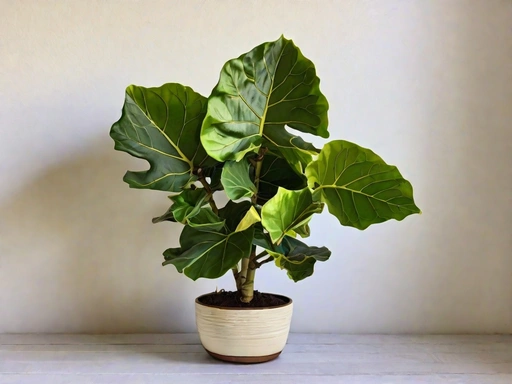
Lighting needs for indoor Fiddle-leaf figs
Indoor Fiddle-leaf figs thrive in bright, indirect light. They need about 6-8 hours of sunlight per day, but it’s important to avoid direct sunlight as it can scorch their leaves.
Place your Fiddle-leaf fig near a north or east-facing window where it can get filtered light throughout the day.
If natural light is limited, you can also use artificial grow lights to meet their lighting needs.
Temperature and humidity considerations for indoor Fiddle-leaf figs
Temperature and humidity are important factors to consider when growing indoor Fiddle-leaf figs. These plants thrive in a temperature range of 60-75°F (16-24°C).
They also prefer humidity levels between 30-65%.
To create a suitable environment, avoid placing your plant near drafts or heating vents, as fluctuating temperatures can stress the plant. Additionally, misting the leaves or using a humidifier can help increase humidity levels.

Best indoor Fiddle-leaf fig varieties
Looking for the best indoor Fiddle-leaf fig varieties? Here are some top picks!
“Ficus lyrata”
“Ficus lyrata,” also known as the Fiddle-leaf fig, is a popular indoor plant known for its large, violin-shaped leaves. It adds a touch of elegance to any space and can grow up to six feet tall indoors.
This variety requires bright, indirect light and regular watering to thrive.
It’s important to keep the leaves clean and dust-free to prevent any potential pest problems. With the right care, “Ficus lyrata” can be a stunning addition to your indoor garden.
“Bambino”
“Bambino” is a compact variety of indoor Fiddle-leaf fig, perfect for smaller spaces.
Its leaves are smaller and more rounded compared to the standard Fiddle-leaf fig.
It still showcases the iconic lush green foliage that makes Fiddle-leaf figs so popular, but in a more manageable size.
Bambino can be a great choice if you want to enjoy the beauty of Fiddle-leaf figs without the worry of it taking up too much space.

“Little Fiddle”
The “Little Fiddle” is a popular variety of indoor Fiddle-leaf fig plants.
It is known for its compact size, making it perfect for smaller spaces.
The leaves are vibrant green and have the signature Fiddle-leaf shape.
“Little Fiddle” requires bright indirect light and regular watering to thrive.
It is relatively easy to care for and adds a touch of greenery to any indoor space.
“Suncoast”
Suncoast is one of the best indoor Fiddle-leaf fig varieties you can choose. It has large, glossy leaves with distinctive veins that add a touch of elegance to any space.
This variety is known for its compact size, making it perfect for smaller indoor spaces.
Suncoast thrives in bright, indirect light and prefers a warm and humid environment. With proper care and attention, Suncoast can be a beautiful addition to your indoor plant collection.
Caring for indoor Fiddle-leaf figs
To care for indoor Fiddle-leaf figs, you’ll need to master proper watering techniques and ensure the right balance of moisture.
Proper watering techniques
Proper watering is vital for the health of your indoor Fiddle-leaf fig. Here are some tips:
- Check the soil moisture by sticking your finger about an inch deep into the soil. If it feels dry, it’s time to water.
- Use room temperature water to avoid shocking the roots.
- Water the plant thoroughly until water drains out of the bottom of the pot, ensuring all roots get hydrated.
- Avoid overwatering – Fiddle-leaf figs prefer to dry out slightly between waterings.
- Adjust watering frequency based on environmental factors like temperature and humidity.
- Consider using a moisture meter to accurately gauge soil moisture levels.
- Avoid letting the plant sit in standing water, as this can lead to root rot.
Remember, finding the right watering schedule may take some trial and error, but with careful observation, you’ll find the perfect balance for your plant’s needs.
Fertilizing indoor Fiddle-leaf figs
To fertilize indoor Fiddle-leaf figs, use a balanced liquid fertilizer with a ratio of 3:1:2, applied every four to six weeks during the growing season. Dilute the fertilizer with water according to the package instructions.
Avoid overfertilizing, as it can lead to burnt roots.
Always water the plant before fertilizing to prevent root damage. Regular fertilizing will help promote healthy growth and vibrant foliage.
Pruning and shaping methods
Pruning and shaping your indoor Fiddle-leaf fig is important to maintain its health and appearance.
To prune, simply trim any dead, damaged, or yellowing leaves with clean pruning shears.
You can also shape your fig by selectively cutting back branches to create a desired shape or size.
Just make sure to do this during the growing season to avoid stunting its growth.
Common pests and diseases to watch out for
Indoor Fiddle-leaf figs are susceptible to a few common pests and diseases.
Keep an eye out for:
- Spider mites: Look for tiny webs and yellowing leaves. Regularly check the underside of the leaves.
- Mealybugs: These pests resemble cottony clusters. They can cause leaf yellowing and sticky residue.
- Scale insects: These pests appear as small, round bumps on the stems and leaves. They can cause plant decline.
As for diseases:
- Root rot: Overwatering can lead to this fungal disease, causing root decay and yellowing leaves.
- Leaf spot: This fungal infection causes small dark spots on the leaves. Prevent by avoiding overhead watering.
Regular inspection and early intervention can help keep your indoor Fiddle-leaf fig healthy and thriving.
Troubleshooting common issues with indoor Fiddle-leaf figs
If you’re experiencing yellowing leaves, leaf drooping, brown spots on leaves, or root rot with your indoor Fiddle-leaf figs, here’s how to troubleshoot these common issues.
Yellowing leaves
Yellowing leaves in indoor Fiddle-leaf figs can indicate various issues.
Some possible causes include overwatering, underwatering, inadequate lighting, or nutrient deficiencies.
To address this, adjust your watering routine, ensure proper lighting, and consider fertilizing if needed.
It’s also important to check for pests or diseases and take appropriate measures.
Leaf drooping
Leaf drooping in indoor Fiddle-leaf figs is often a sign of underwatering.
Make sure to check the moisture level of the soil before watering and adjust the frequency accordingly.
Inconsistent watering can also cause leaf drooping, so strive for a consistent watering schedule.
Additionally, ensure that your fiddle-leaf fig is receiving adequate light and avoid placing it in drafts or extreme temperatures.
Brown spots on leaves
Brown spots on leaves of indoor Fiddle-leaf figs can be caused by various issues, such as overwatering, underwatering, or exposure to direct sunlight.
To address this problem, ensure proper watering techniques, provide adequate sunlight, and check for pests.
Prune affected leaves if necessary.
Root rot
Root rot is a common issue with indoor Fiddle-leaf figs.
It occurs when the roots are exposed to too much water or poor drainage.
To prevent root rot, ensure your plant is not overwatered and has proper drainage.
If you notice signs of root rot, such as yellowing leaves, wilting, or a foul smell, take action immediately.
Trim affected roots and repot the plant in fresh, well-draining soil.
Adjust your watering routine to avoid future problems.
Frequently Asked Questions about indoor Fiddle-leaf figs
How often should I water my indoor Fiddle-leaf fig?
Water your indoor Fiddle-leaf fig thoroughly when the top inch of soil feels dry to the touch.
The frequency may vary depending on factors like temperature and humidity, but on average, it is recommended to water every 7-10 days.
Remember not to overwater, as this can lead to root rot.
Can I place my Fiddle-leaf fig near a window with direct sunlight?
Yes, you can place your Fiddle-leaf fig near a window with direct sunlight. Fiddle-leaf figs thrive in bright, indirect light, but they can also tolerate some direct sunlight.
Just be mindful of intense, hot afternoon sun as it may burn the leaves.
Monitor the plant and adjust its position accordingly for optimal growth.
What should I do if my Fiddle-leaf fig starts losing leaves?
If your Fiddle-leaf fig starts losing leaves, there are a few things you can do. Check the soil moisture and make sure you’re not over or under-watering.
Ensure that the plant is receiving adequate sunlight.
Also, inspect for signs of pests or disease. Adjusting these factors can help your plant recover.
How can I prevent pests from infesting my indoor Fiddle-leaf fig?
To prevent pests from infesting your indoor Fiddle-leaf fig, regularly inspect your plant for any signs of pests like spider mites or scale insects.
Wipe the leaves with a damp cloth to remove dust and potential pests.
Avoid overwatering, as this can attract pests.
Also, isolate any new plants before introducing them to your Fiddle-leaf fig to prevent potential infestations.
Final Verdict
When it comes to choosing the best indoor Fiddle-leaf fig varieties, there are several options to consider. The Ficus lyrata is a classic choice with its large, striking leaves.
The Bambino is a more compact variety that is perfect for smaller spaces.
The Little Fiddle is ideal for those looking for a smaller, bushier option, while the Suncoast is a unique variety with yellow variegation. Regardless of which variety you choose, proper care, including watering, fertilizing, and pruning, is crucial for their health.
By following these guidelines and troubleshooting common issues, you can enjoy the beauty and benefits of indoor Fiddle-leaf figs in your home.

